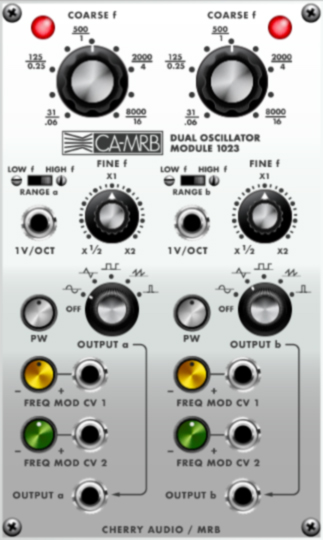
The 1023 Dual Oscillator contains two independent, full-function oscillator modules. It's essentially the same as two of the 1004-style oscillators in one module, less the pulse-width modulation CV inputs. These can be used in the audio range, or as low-frequency modulation sources. Since the controls for each side are exact duplicates, we'll go over them just once.
Inputs, Outputs, and Controls
Oscillator active lamp- The red lamps in the upper corners glow to indicate the oscillator is enabled (either side can be disabled by setting the waveform selector knob to Off).
Frequency / Coarse and Fine- The Coarse control sets the base frequency over a nine-octave range, in octave increments. The Fine control allows continuous fine pitch control and is configured as a "multiplier" with center position being nominal and a range of 1/2 pitch to the left or double the pitch to the right (i.e., +/- one octave).
Range- Generally this will be set to Low when using as a mod source, or high for audio-range signals.
1V/Oct jack- Accepts a CV input for pitch. Typically this would come from the Pitch jack in the IO Panel CV Out section, or from a sequencer CV out.
Pulse Width (PW)- This sets the width or "duty-cycle" of the pulse wave (the very bottom waveform on the panel). It has no effect on any other waveform. Its default setting of 50% outputs a perfect square wave, rich in odd-order harmonics. Moving the knob left or right narrows its width as well as the thickness of sound until it almost disappears at its extremes.
Output a/b wave selector- Selects off, sine, triangle, square, ramp, or pulse wave output. The red lamp in the upper corner dims in Off position.
Frequency Mod 1 and 2 input jack and attenuator- This is used for externally modulating the oscillator frequency. It's useful for adding vibrato with an LFO, siren noises, envelope-controlled pitch sweeps, etc. The attenuator knob is bipolar; it allow positive (turn right) or inverted voltage control (turn left). It defaults to center zero position.
All mod inputs are exponential, that is for a given mod input voltage, the mod amount increases as frequency increases. For example, if the base frequency is 1000 Hz, and a bipolar wave is applied to the mod CV input, the frequency falls to 500 Hz and rises to 2000 Hz. Because audio frequencies are inherently exponential in nature, the resulting frequency rises and falls exactly one octave.
Output a/b jacks- Audio output of oscillator waveforms.